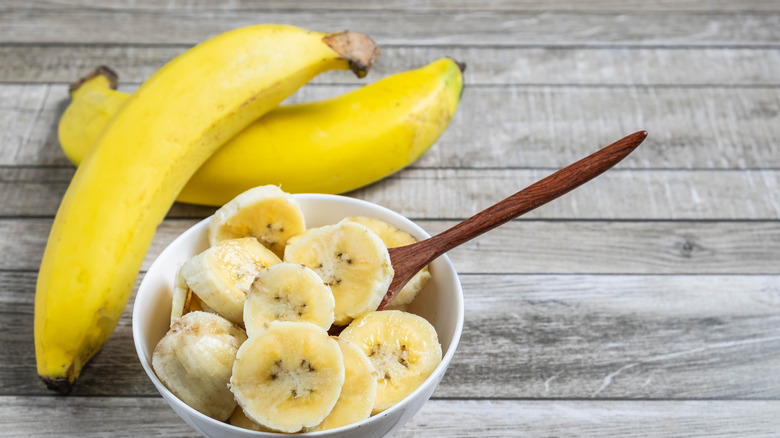What's The Difference Between Red And Yellow Bananas?
Bananas are one of the most popular fruits, both because of their great taste, their convenience, and their many health benefits. But they are also a fruit you may not put a lot of thought into, so you may not realize there are around 1,000 different varieties grown today. You may not have heard of different varieties like Blue Java, Praying Hands, or Fehi, but you've undoubtedly seen yellow bananas and red bananas in the grocery store.
Just like bananas and plantains are similar yet different, yellow bananas and red bananas are close but not quite the same. If the difference intimidates you, knowing the differences between these two popular varieties can make your next shopping trip a little more interesting. Add that to knowing that bananas are actually a type of berry (we are just as surprised as you are!) and the fact that Americans have been importing from tropical climates since 1870, and your banana knowledge is sure to give you an edge above your foodie friends.
Yellow bananas are delicious, nutritious, and extremely versatile
What we know as yellow bananas are actually a specific variety known as Cavendish, a uniform yellow banana that is the most widely available banana available outside of areas where bananas are native. A different banana variety was once the norm, but thanks to a fungal plant disease called Panama Disease, the once widely available variety known as Gros Michel was nearly wiped out and replaced with Cavendish. The two varieties are very similar in taste and appearance, but while Gros Michel are still grown in some parts of the world, they are not found in American markets.
The bright yellow of the peel is unmistakable and immediately recognizable, and the white flesh inside is creamy with a slightly sweet taste. These lovely bananas are extremely versatile, enjoyed raw right from the peel, incorporated into smoothies, oatmeal, cereal, and ice cream, and can be used in sweet and savory baked goods like pancakes or banana bread.
Red bananas are a nutritional powerhouse
Red bananas, which are grown in Southeast Asia, are found in many grocery stores, but consumers don't always know what to do with them. They are smaller and denser than yellow bananas, and are known to have a sight raspberry flavor when ripe. Red bananas have a great reputation nutritionally and are believed to have a positive influence on the immune system, blood pressure, eye health, and digestive health.
Red bananas are considered to be a healthy addition to a diet rich in fruits and vegetables. Like yellow bananas, they are high in dietary fiber and vitamins like vitamin C, but they are also high in antioxidants and have a lower glycemic index than yellow bananas, which makes them a smart option for anyone looking for support in controlling their blood sugar. Because red bananas have denser flesh than their yellow counterparts, they are great in cooked dishes, both sweet and savory, like bananas foster, added to a curry, or even used as a surprising base for an elevated banana split that features grilled bananas rather than raw ones.


